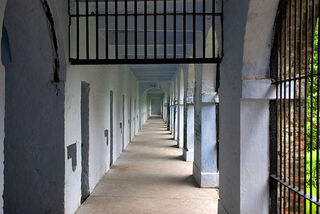Health
Mental Health Woes and Torture in Indian Prisons
The Indian medical community is largely silent about human rights violations.
Posted April 10, 2021 Reviewed by Lybi Ma
Key points
- Torture is common, and mental health disorders abound in Indian prisons, yet the Indian medical community is largely silent.
- Based on a survey conducted at one Indian medical school, many physicians are not taught about abuses inside prison walls.
- Physicians should be leading reform efforts to create more humane conditions within prisons and jails.

This post was co-authored by Shivam Singh, Farhad R. Udwadia, and J. Wesley Boyd.
“It is said that no one truly knows a nation until one has been inside its jails. A nation should not be judged by how it treats its highest citizens, but its lowest ones.” —Nelson Mandela
Conditions inside Indian prisons are poor at best and all too frequently simply abhorrent. Many of these prisons are overcrowded, breeding grounds for infections like HIV and TB, and home to high rates of mental health conditions, torturous practices, and more. (1) Indian law guarantees those who are incarcerated fundamental protections, including freedom from torture and the right to health care. (2) But sadly, the vast majority of incarcerated individuals in India lack access to adequate—if any—medical or mental health care and face a myriad of other injustices as well. Given this reality, it is not surprising that mental health disorders are dramatically higher amongst Indian prisoners than in the rest of India. (3)
In addition, torture is common and contributes to the mental health burdens as well as mortality faced by prisoners. (4) Prisoners are often tortured soon after being placed in police custody: One study found that “99 percent of deaths in police custody can be ascribed to torture and occur within 48 hours of the victims being taken into custody.” (5) Prisoners on death row are particularly likely to be tortured, including experiences like “being hung by wires, being forced to drink urine, being placed on a slab of ice, having a leg broken, forced anal penetration and more.” (6) The upshot is that torture in Indian prisons is rampant, extreme, and exacts a huge toll on the health and well-being of incarcerated individuals.
Given this reality, one would think that the medical establishment would be campaigning for reforms, but Indian physicians remain largely silent. We believe that the silence from the medical community is not borne out of callousness, but instead out of a lack of knowledge about what occurs inside their prisons. We think this because we conducted a survey of Indian medical students and found that they knew very little about health-related human rights violations in Indian prisons, as well as the ethical norms and legal rights granted to prisoners. Our study was just published in the Harvard Medical School Journal of Bioethics and can be found here. (7)
In our study, we surveyed an entire class of medical students who were in their final year of study at a prominent Indian medical school about their knowledge and attitudes towards prisoner health and human rights. Ninety-two percent reported that they received less than one hour of education regarding prisoner health and access to health care, and 86 percent believed that medical students ought to receive more education about these matters.
Students were woefully ignorant in various ways: For example, 55 percent of the surveyed students agreed that solitary confinement was an acceptable form of punishment, even though it is widely considered to be torture. Given this response, it is not surprising that 30 percent were unsure about the acceptability of employing coercive traumatic tactics, such as beating and waterboarding, that also constitute torture by internationally accepted standards. Of even greater concern, 41 percent felt these practices were acceptable. In addition, 38 percent agreed that it was permissible for physicians to participate in capital punishment.
Even though some might assert that prisoners deserve harsh punishments, it is worth noting that nearly two-thirds of the prison population in India has not been convicted of any crimes, but instead is awaiting trial. (8) A great deal of these “under-trial” prisoners are poor, uneducated, and have been charged with only minor violations of the law, with poor access to legal or financial resources. (9) So not only is it possible that they are not guilty of any crimes, the sad reality is that they likely had no effective legal representation to prove their innocence.
And no matter their guilt, the majority of those who are incarcerated will eventually reintegrate into society, carrying their mental health and disease burdens back into their collective communities and health care systems. Given this reality, ought the Indian medical community not be more vocal about the atrocities Indian prisoners suffer?
Ethical and societal considerations aside, prisoners are legally protected by the Indian constitution and are privy to the same fundamental rights around health care as everybody else. (10) The practices that have become the daily norm inside Indian prisons flout both Indian and international law.
In summary, our study suggests that graduating physicians from Indian medical schools are unaware of the health-related human rights violations and torture occurring inside Indian prisons. This, in turn, could explain the relative silence and lack of advocacy on their behalf. More education is needed to fully inform these future physicians on the nature of such legal and ethical violations. Doctors are a powerful lobbying group, and with a strong unified voice, perhaps they can start to affect change for the vulnerable individuals inside their prison walls.
About the authors:
Shivam Singh, MBE, is a bioethicist and graduate of Harvard Medical School Center for Bioethics, Boston, Massachusetts, USA.
Farhad R. Udwadia, MBE, is a bioethicist, HMS Center for Bioethics, and medical student, University of British Columbia, Vancouver, British Columbia, Canada.
References
[1] PTI. "India: overcrowding prisons a violation of human rights, says Supreme Court." The Hindu (Chennai, India) May 13, 2
Dolan, Kate and Sarah Larney. "HIV in Indian prisons: Risk behaviour, prevalence, prevention & treatment." Indian Journal of Medical Research 132, no. 6 (2010): pp. 696-700.
Prasad, Banuru Muralidhara, Badri Thapa, Sarabjit Singh Chadha, Anand Das, Entoor Ramachandra Babu, Subrat Mohanty, Sripriya Pandurangan, and Jamhoih Tonsing. "Status of Tuberculosis services in Indian Prisons." International Journal of Infectious Diseases 56 (2017): pp. 117-121. https://doi.org/10.1016/j.ijid.2017.01.035
Goyal, Sandeep Kumar, Paramjit Singh, Parshotam D. Gargi, Samta Goyal, and Aseem Garg. "Psychiatric morbidity in prisoners." Indian Journal of Psychiatry 53, no. 3 (2011): pp. 253-257. https://doi.org/10.4103/0019-5545.86819
Death Penalty Research Project, Project 39A. Death Penalty India Report Summary. Death Penalty Research Project. May 6, 2016. https://www.project39a.com/dpir.
[2] Lokur MB. "Re: Inhuman Conditions in 1382 Prisons… vs State of Assam on 13 December, 2018." Supreme Court of India. Decmber 13, 2018. https://indiankanoon.org/doc/143664436/.
Sunil Batra v. Delhi Administration, 2 SCR 557 (1980). Supreme Court of India. https://indiankanoon.org/doc/778810/.
[3] Goyal (see note 1).
[4] De C Williams Amanda C. and Jannie van der Merwe. "The psychological impact of torture." British Journal of Pain 7, no. 2 (2013): pp. 101-106. https://doi.org/10.1177/2049463713483596
[5] Randolph, Eric. "Human rights report says 14,000 Indian prison deaths in a decade." The National (Abu Dhabi, UAE) November 23, 2011.
https://www.thenationalnews.com/world/asia/human-rights-report-says-14-…
[6] Death Penalty Research Project, Project 39A (see note 1).
[7] Singh, Udwadia, Sadeghieh, Boyd. “The Role of Medical Personnel in Improving Prisoner Rights and Health in India”. Harvard Medical School Bioethics Journal. April 1st, 2021. https://bioethics.hms.harvard.edu/journal/prisoner-rights
[8] Government of India; Ministry of Home Affairs. Prison Statistics India 2016; Executive Summary. New Delhi, India: National Crime Records Bureau, updated May 12, 2019. http://ncrb.gov.in/sites/default/files/Executive%20Summary-2016.pdf.
[9] Ibid.
[10] Jain, Riya. "Article 21 of the Constitution of India - Right to Life and Personal Liberty." Lawctopus (Chandigarh, India) November 13, 2015.
www.lawctopus.com/academike/article-21-of-the-constitution-of-india-rig….
Parmanand Katara v. Union Of India & Ors, 3 SCR 997 (1989). Supreme Court of India. https://indiankanoon.org/doc/498126/


